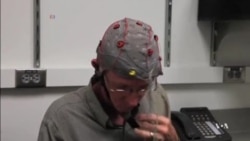ບັນດານາຍແພດ ກ່າວວ່າ ພວກຄົນເຈັບ ທີ່ເປັນລົມສາລະບາດ
ໂດຍສ່ວນໃຫຍ່ແລ້ວ ໄລຍະເວລາສຳຫລັບການຟື້ນໂຕຄືນໄດ້ນັ້ນ
ຈະໝົດລົງ ຫຼັງຈາກ 6 ເດືອນ. ໃນເວລານີ້ ມີອຸປະກອນອັນໜຶ່ງ ທີ່
ເຊື່ອມຕໍ່ ສັນຍານຕ່າງໆ ຈາກສະໝອງໄປຍັງຮ່າງກາຍ ທີ່ສະແດງ
ໃຫ້ເຫັນວ່າ ຍັງມີຄວາມຫວັງຢູ່ ທີ່ຈະປັບປຸງການເຄື່ອນໄຫວ ຫຼັງ
ຈາກທີ່ໄດ້ເປັນລົມສາລະບາດ ມາໄດ້ດົນນານແລ້ວ. ຜູ້ສື່ຂ່າວ
ວີໂອເອ Maia Pujara ມີລາຍງານເລື້ອງນີ້ ຊຶ່ງໄຊຈະເລີນສຸກ
ຈະນຳມາສະເໜີທ່ານ ໃນອັນ ດັບຕໍ່ໄປ.
ໃນເມື່ອ ການເປັນລົມສາລະບາດ ບໍ່ແມ່ນແຕ່ພຽງຄັ້ງດຽວ ຫຼື ສອງຄັ້ງ ແຕ່ວ່າສາມຄັ້ງ ຊຶ່ງໄດ້ ເຮັດໃຫ້ ທ່ານ Rick Arnold ເປັນອຳມະພຶກ ຢູ່ເບື້ອງຂວາຂອງຮ່າງກາຍລາວ ແລະ ໂອກາດທີ່ຈະຟື້ນໂຕຄືນໄດ້ນັ້ນ ແມ່ນມີພຽງໜ້ອຍດຽວ. ທ່ານArnold ອະດີດນາຍແພດ ປະຈຳໜ່ວຍ ດັບເພີງ ທີ່ກະສຽນແລ້ວ ບອກກັບພັນລະຍາ ທ່ານນາງ Kim ວ່າ ລາວຕ້ອງ ການພຽງຢ່າງດຽວ ໃນລະຫວ່າງເວລາ ທີ່ຕົກຍາກລຳບາກນີ້.
ດັ່ງນັ້ນ ທ່ານ Arnold ເລີຍໄປຂໍຄວາມຊ່ອຍເຫຼືອ ຈາກ ດຣ. Eric Leuthardt ຊຶ່ງເປັນໝໍຜ່າຕັດທາງເສັ້ນປະສາດ ຢູ່ທີ່ ມະຫາວິທະຍາໄລ Washington ໃນນະຄອນ
St. Louis ລັດ Missouri ຜູ້ທີ່ກຳລັງເຮັດວຽກ ກ່ຽວກັບອຸປະກອນອັນໜຶ່ງ ທີ່ອາດປ່ຽນ
ຊີວິດການເປັນຢູ່ ຂອງພວກຄົນເຈັບ ຄືກັບທ່ານ Arnold ນັ້ນ.
ດຣ. Leuthardt ກ່າວວ່າ ເຖິງແມ່ນວ່າ ເບື້ອງໜຶ່ງຂອງສະໝອງ ຄວບຄຸມ ຮ່າງກາຍ
ຟາກກົງກັນຂ້າມ ແລະ ອີກສ່ວນໜຶ່ງຂອງສະໝອງ ສາມາດ “ເຈາະເອົາ” ພວກສັນ
ຍານ ເພື່ອທີ່ຈະເຊື່ອມຕໍ່ຄືນການສື່ສານ ລະຫວ່າງ ສະໝອງ ແລະ ຮ່າງກາຍ.
ດຣ. Leuthardt ເວົ້າວ່າ “ພວກເຮົາກຳລັງເອົາສັນຍານຈາກສະໝອງ ເບື້ອງທີ່
ບໍ່ໄດ້ຮັບຜົນກະທົບ ແລ້ວເອົາມາຖອດລະຫັດ ຂອງຈຸດປະສົງ ທີ່ຢາກຈະເຄື່ອນ
ໄຫວນັ້ນ. ທັງໆທີ່ ພວກເຂົາ ບໍ່ສາມາດເຄື່ອນໄຫວໄດ້ ພວກເຮົາຮູ້ດີວ່າ ພວກ
ເຂົາເຈົ້າຢາກຈະ ເຄື່ອນຍ້າຍ.”
ໃນເວລາ ທ່ານ Arnold ສວມໃສ່ອຸປະກອນດັ່ງກ່າວແລ້ວ ແລະ ນຶກຄິດຢາກເຄື່ອນຍ້າຍ
ອຸປະກອນນັ້ນຈະບອກໃຫ້ “ເຄື່ອງຈັກມືຈຳລອງ” ທີ່ຄວບຄຸມໂດຍຄອມພິວເຕີ້ ໃຫ້ກຳມື
ແລະ ເຄື່ອນຍ້າຍມືຂອງລາວ.
ອຸປະກອນດັ່ງກ່າວ ທຳງານຄືກັນກັບ ຜູ້ຄວບຄຸມການສັນຈອນ ເພື່ອປ່ຽນເສັ້ນທາງການ
ເລື່ອນໄຫລຂອງຂໍ້ມູນ ຈາກສະໝອງ ໄປຫາມື ແລະ ກັບຄືນມາອີກ. ມັນຈະເສີມຂະຫຍາຍ
ຄວາມອາດສາມາດ ທີ່ເປັນທຳມະຊາດຂອງສະໝອງ ເພື່ອຈະເຊື່ອມຕໍ່ກັນຄືນອີກ ດ້ວຍ
ຕົວມັນເອງ ຫຼັງຈາກເປັນອຳມະພຶກແລ້ວນັ້ນ.
ດຣ. Leuthardt ເວົ້າວ່າ “ທ່ານ Rick ເປັນລົມສະລາບາດ ມາໄດ້ 3 ຫາ 4 ປີແລ້ວ ແລະ ພວກເຮົາຍັງສາມາດກະຕຸ້ນຄືນ ການຢືດເສັ້ນໃຫ້ລາວຄືນໃໝ່ ເພື່ອທີ່ຈະ
ເຝິກສອນວົງຈອນສະໝອງຂອງລາວ.”
ທ່ານ Arnold ເວົ້າວ່າ “ທຸກໆມື້ ແມ່ນວັນຄຣິສມັສ. ທຸກຢ່າງທັງໝົດ ພວມທຳງານ
ມັນກຳລັງລົງໂຕ ໃນທາງທີ່ທ່ານຕ້ອງການຢາກໃຫ້ມັນເປັນໄປ. ອາການຂອງ
ຂ້າພະເຈົ້າ ແມ່ນໄດ້ ເລີຍກາຍ ອັນທີ່ແຕ່ລະຄົນຄິດເອົາໄວ້ ລວມທັງຂ້າພະເຈົ້າ
ເອງ ຊຶ່ງມັນດີຂຶ້ນຫຼາຍ.”
ເຖິງແມ່ນວ່າ ພວກຄົນເຈັບ ຈາກການເປັນລົມສະລາບາດ ຄືກັນກັບ ທ່ານ Arnold
ປະເຊີນໜ້າກັບ ອຸປະສັກຫຼາຍຢ່າງ ໃນເສັ້ນທາງຂອງການຟື້ນຟູສຸຂະພາບນັ້ນ ດ້ວຍ
ເທັກໂນໂລຈີ້ໃໝ່ ຄືກັບອຸບປະກອນທີ່ມີຄຸນຄ່າດັ່ງກ່າວນີ້ ສາມາດຊ່ອຍເຫຼືອພວກເຂົາ
ໄດ້ ໃນການຈັບມືກັບຄົນຮັກຂອງພວກເຂົາເຈົ້າ ໄດ້ອີກຄັ້ງໜຶ່ງ.
Doctors say for most stroke victims the window for recovery shuts after six months. Now, a device that links signals from the brain to the body shows promise in improving movement long after a stroke hits. VOA's Maia Pujara reports.
When not one, or two, but three strokes left Rick Arnold paralyzed on the right side of his body, his chances of recovery were slim.The retired paramedic firefighter told his wife Kim he wanted only one thing during that difficult time.
(RICK ARNOLD, PATIENT)
"All I really wanted to do was to be able to hold her hand. In the very beginning, it was to hold her hand."
So Arnold sought help from Dr. Eric Leuthardt.
The neurosurgeon at Washington University in St. Louis is working on a device that could change the lives of patients like Arnold.
He says although one side of the brain controls the opposite side of the body, other parts of the brain can be "tapped" for signals to re-wire communication between the brain and the body.
(DR. ERIC LEUTHARDT, WASHINGTON UNIVERSITY)
"We're taking a signal from the uninjured side of the brain and decoding that intention to move. Even though they can't move, we know that they want to move."
When Arnold straps on the device and thinks about moving, the machine tells the computerized "exoskeleton" hardware to grip and move his hand.
The device works like a traffic controller to redirect the flow of information from the brain to the hand and back again. It enhances the brain's natural ability to re-wire itself after injury.
(DR. ERIC LEUTHARDT, WASHINGTON UNIVERSITY)
"Rick was three to four years out from his stroke, and we can still recharge his plasticity for him to train his brain circuitry."
And Arnold has reaped the benefits of this new technology.
(RICK ARNOLD, PATIENT)
"Every day is Christmas. It's all working, it's just falling into place the way you want it to be.I am going way beyond what anyone thought including myself, much better."
Though stroke victims like Arnold face many obstacles on the road to recovery, new technologies like this can go a long way in helping them hold the hands of their loved ones once again.





